FORD FIESTA 1989 Service Repair Manual
Manufacturer: FORD, Model Year: 1989, Model line: FIESTA, Model: FORD FIESTA 1989Pages: 296, PDF Size: 10.65 MB
Page 181 of 296
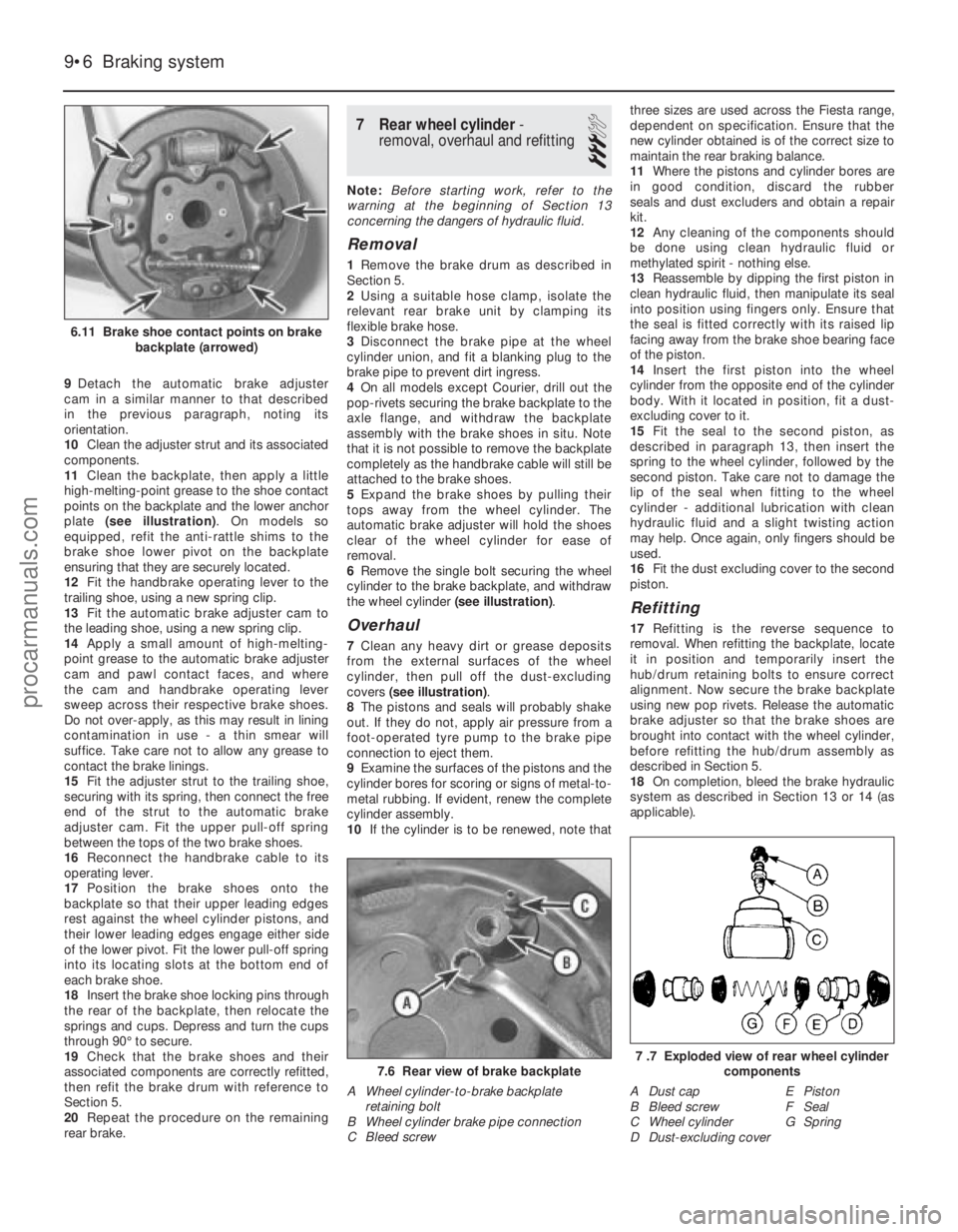
9Detach the automatic brake adjuster
cam in a similar manner to that described
in the previous paragraph, noting its
orientation.
10 Clean the adjuster strut and its associated
components.
11 Clean the backplate, then apply a little
high-melting-point grease to the shoe contact
points on the backplate and the lower anchor
plate (see illustration) . On models so
equipped, refit the anti-rattle shims to the
brake shoe lower pivot on the backplate
ensuring that they are securely located.
12 Fit the handbrake operating lever to the
trailing shoe, using a new spring clip.
13 Fit the automatic brake adjuster cam to
the leading shoe, using a new spring clip.
14 Apply a small amount of high-melting-
point grease to the automatic brake adjuster
cam and pawl contact faces, and where
the cam and handbrake operating lever
sweep across their respective brake shoes.
Do not over-apply, as this may result in lining
contamination in use - a thin smear will
suffice. Take care not to allow any grease to
contact the brake linings.
15 Fit the adjuster strut to the trailing shoe,
securing with its spring, then connect the free
end of the strut to the automatic brake
adjuster cam. Fit the upper pull-off spring
between the tops of the two brake shoes.
16 Reconnect the handbrake cable to its
operating lever.
17 Position the brake shoes onto the
backplate so that their upper leading edges
rest against the wheel cylinder pistons, and
their lower leading edges engage either side
of the lower pivot. Fit the lower pull-off spring
into its locating slots at the bottom end of
each brake shoe.
18 Insert the brake shoe locking pins through
the rear of the backplate, then relocate the
springs and cups. Depress and turn the cups
through 90° to secure.
19 Check that the brake shoes and their
associated components are correctly refitted,
then refit the brake drum with reference to
Section 5.
20 Repeat the procedure on the remaining
rear brake.
7 Rear wheel cylinder -
removal, overhaul and refitting
3
Note: Before starting work, refer to the
warning at the beginning of Section 13
concerning the dangers of hydraulic fluid.
Removal
1 Remove the brake drum as described in
Section 5.
2 Using a suitable hose clamp, isolate the
relevant rear brake unit by clamping its
flexible brake hose.
3 Disconnect the brake pipe at the wheel
cylinder union, and fit a blanking plug to the
brake pipe to prevent dirt ingress.
4 On all models except Courier, drill out the
pop-rivets securing the brake backplate to the
axle flange, and withdraw the backplate
assembly with the brake shoes in situ. Note
that it is not possible to remove the backplate
completely as the handbrake cable will still be
attached to the brake shoes.
5 Expand the brake shoes by pulling their
tops away from the wheel cylinder. The
automatic brake adjuster will hold the shoes
clear of the wheel cylinder for ease of
removal.
6 Remove the single bolt securing the wheel
cylinder to the brake backplate, and withdraw
the wheel cylinder (see illustration).
Overhaul
7Clean any heavy dirt or grease deposits
from the external surfaces of the wheel
cylinder, then pull off the dust-excluding
covers (see illustration) .
8 The pistons and seals will probably shake
out. If they do not, apply air pressure from a
foot-operated tyre pump to the brake pipe
connection to eject them.
9 Examine the surfaces of the pistons and the
cylinder bores for scoring or signs of metal-to-
metal rubbing. If evident, renew the complete
cylinder assembly.
10 If the cylinder is to be renewed, note that three sizes are used across the Fiesta range,
dependent on specification. Ensure that the
new cylinder obtained is of the correct size to
maintain the rear braking balance.
11
Where the pistons and cylinder bores are
in good condition, discard the rubber
seals and dust excluders and obtain a repair
kit.
12 Any cleaning of the components should
be done using clean hydraulic fluid or
methylated spirit - nothing else.
13 Reassemble by dipping the first piston in
clean hydraulic fluid, then manipulate its seal
into position using fingers only. Ensure that
the seal is fitted correctly with its raised lip
facing away from the brake shoe bearing face
of the piston.
14 Insert the first piston into the wheel
cylinder from the opposite end of the cylinder
body. With it located in position, fit a dust-
excluding cover to it.
15 Fit the seal to the second piston, as
described in paragraph 13, then insert the
spring to the wheel cylinder, followed by the
second piston. Take care not to damage the
lip of the seal when fitting to the wheel
cylinder - additional lubrication with clean
hydraulic fluid and a slight twisting action
may help. Once again, only fingers should be
used.
16 Fit the dust excluding cover to the second
piston.
Refitting
17 Refitting is the reverse sequence to
removal. When refitting the backplate, locate
it in position and temporarily insert the
hub/drum retaining bolts to ensure correct
alignment. Now secure the brake backplate
using new pop rivets. Release the automatic
brake adjuster so that the brake shoes are
brought into contact with the wheel cylinder,
before refitting the hub/drum assembly as
described in Section 5.
18 On completion, bleed the brake hydraulic
system as described in Section 13 or 14 (as
applicable).
9•6 Braking system
7 .7 Exploded view of rear wheel cylinder
components
A Dust cap E Piston
B Bleed screw F Seal
C Wheel cylinder G Spring
D Dust-excluding cover7.6 Rear view of brake backplate
A Wheel cylinder-to-brake backplate retaining bolt
B Wheel cylinder brake pipe connection
C Bleed screw
6.11 Brake shoe contact points on brake backplate (arrowed)
1595Ford Fiesta Remakeprocarmanuals.com
http://vnx.su
Page 182 of 296
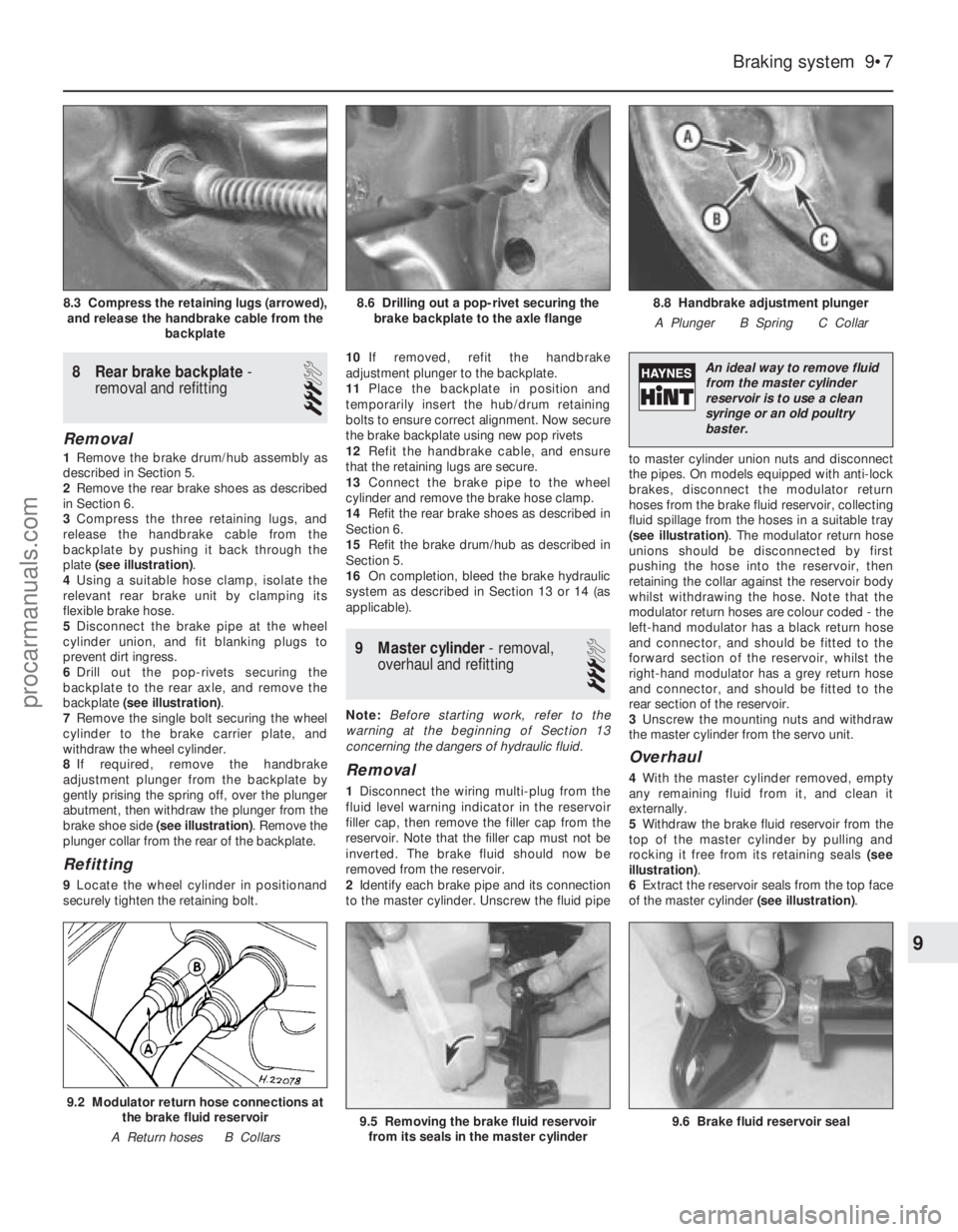
8 Rear brake backplate-
removal and refitting
3
Removal
1 Remove the brake drum/hub assembly as
described in Section 5.
2 Remove the rear brake shoes as described
in Section 6.
3 Compress the three retaining lugs, and
release the handbrake cable from the
backplate by pushing it back through the
plate (see illustration) .
4 Using a suitable hose clamp, isolate the
relevant rear brake unit by clamping its
flexible brake hose.
5 Disconnect the brake pipe at the wheel
cylinder union, and fit blanking plugs to
prevent dirt ingress.
6 Drill out the pop-rivets securing the
backplate to the rear axle, and remove the
backplate (see illustration) .
7 Remove the single bolt securing the wheel
cylinder to the brake carrier plate, and
withdraw the wheel cylinder.
8 If required, remove the handbrake
adjustment plunger from the backplate by
gently prising the spring off, over the plunger
abutment, then withdraw the plunger from the
brake shoe side (see illustration) . Remove the
plunger collar from the rear of the backplate.
Refitting
9 Locate the wheel cylinder in positionand
securely tighten the retaining bolt. 10
If removed, refit the handbrake
adjustment plunger to the backplate.
11 Place the backplate in position and
temporarily insert the hub/drum retaining
bolts to ensure correct alignment. Now secure
the brake backplate using new pop rivets
12 Refit the handbrake cable, and ensure
that the retaining lugs are secure.
13 Connect the brake pipe to the wheel
cylinder and remove the brake hose clamp.
14 Refit the rear brake shoes as described in
Section 6.
15 Refit the brake drum/hub as described in
Section 5.
16 On completion, bleed the brake hydraulic
system as described in Section 13 or 14 (as
applicable).
9 Master cylinder - removal,
overhaul and refitting
3
Note: Before starting work, refer to the
warning at the beginning of Section 13
concerning the dangers of hydraulic fluid.
Removal
1 Disconnect the wiring multi-plug from the
fluid level warning indicator in the reservoir
filler cap, then remove the filler cap from the
reservoir. Note that the filler cap must not be
inverted. The brake fluid should now be
removed from the reservoir.
2 Identify each brake pipe and its connection
to the master cylinder. Unscrew the fluid pipe to master cylinder union nuts and disconnect
the pipes. On models equipped with anti-lock
brakes, disconnect the modulator return
hoses from the brake fluid reservoir, collecting
fluid spillage from the hoses in a suitable tray
(see illustration)
. The modulator return hose
unions should be disconnected by first
pushing the hose into the reservoir, then
retaining the collar against the reservoir body
whilst withdrawing the hose. Note that the
modulator return hoses are colour coded - the
left-hand modulator has a black return hose
and connector, and should be fitted to the
forward section of the reservoir, whilst the
right-hand modulator has a grey return hose
and connector, and should be fitted to the
rear section of the reservoir.
3 Unscrew the mounting nuts and withdraw
the master cylinder from the servo unit.
Overhaul
4 With the master cylinder removed, empty
any remaining fluid from it, and clean it
externally.
5 Withdraw the brake fluid reservoir from the
top of the master cylinder by pulling and
rocking it free from its retaining seals (see
illustration) .
6 Extract the reservoir seals from the top face
of the master cylinder (see illustration).
Braking system 9•7
8.8 Handbrake adjustment plunger
A Plunger B Spring C Collar8.6 Drilling out a pop-rivet securing the brake backplate to the axle flange8.3 Compress the retaining lugs (arrowed),and release the handbrake cable from the backplate
9.5 Removing the brake fluid reservoirfrom its seals in the master cylinder
9.2 Modulator return hose connections at the brake fluid reservoir
A Return hoses B Collars
9
1595Ford Fiesta Remake 9.6 Brake fluid reservoir seal
An ideal way to remove fluid
from the master cylinder
reservoir is to use a clean
syringe or an old poultry
baster.
procarmanuals.com
http://vnx.su
Page 183 of 296
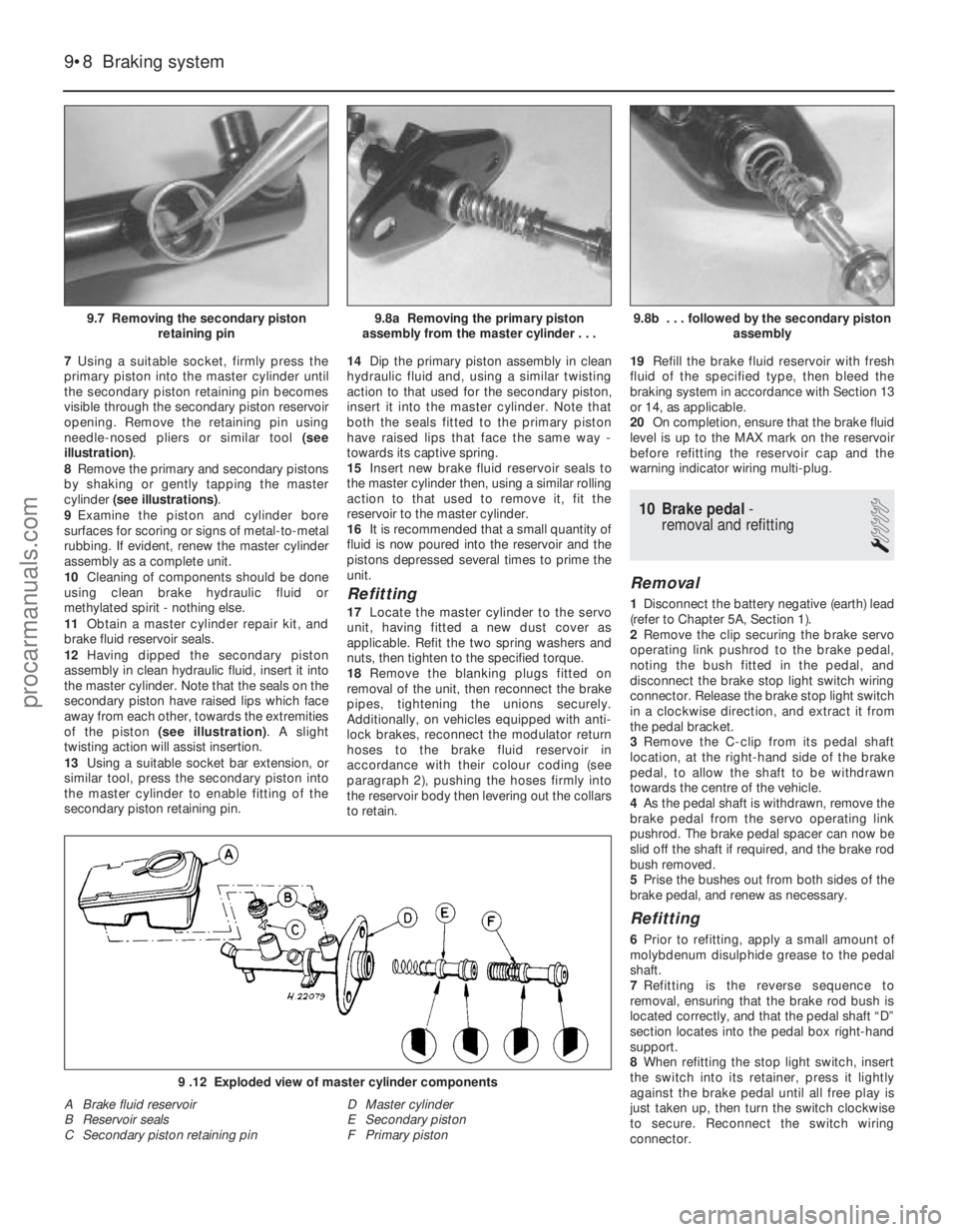
7Using a suitable socket, firmly press the
primary piston into the master cylinder until
the secondary piston retaining pin becomes
visible through the secondary piston reservoir
opening. Remove the retaining pin using
needle-nosed pliers or similar tool (see
illustration) .
8 Remove the primary and secondary pistons
by shaking or gently tapping the master
cylinder (see illustrations) .
9 Examine the piston and cylinder bore
surfaces for scoring or signs of metal-to-metal
rubbing. If evident, renew the master cylinder
assembly as a complete unit.
10 Cleaning of components should be done
using clean brake hydraulic fluid or
methylated spirit - nothing else.
11 Obtain a master cylinder repair kit, and
brake fluid reservoir seals.
12 Having dipped the secondary piston
assembly in clean hydraulic fluid, insert it into
the master cylinder. Note that the seals on the
secondary piston have raised lips which face
away from each other, towards the extremities
of the piston (see illustration) . A slight
twisting action will assist insertion.
13 Using a suitable socket bar extension, or
similar tool, press the secondary piston into
the master cylinder to enable fitting of the
secondary piston retaining pin. 14
Dip the primary piston assembly in clean
hydraulic fluid and, using a similar twisting
action to that used for the secondary piston,
insert it into the master cylinder. Note that
both the seals fitted to the primary piston
have raised lips that face the same way -
towards its captive spring.
15 Insert new brake fluid reservoir seals to
the master cylinder then, using a similar rolling
action to that used to remove it, fit the
reservoir to the master cylinder.
16 It is recommended that a small quantity of
fluid is now poured into the reservoir and the
pistons depressed several times to prime the
unit.
Refitting
17 Locate the master cylinder to the servo
unit, having fitted a new dust cover as
applicable. Refit the two spring washers and
nuts, then tighten to the specified torque.
18 Remove the blanking plugs fitted on
removal of the unit, then reconnect the brake
pipes, tightening the unions securely.
Additionally, on vehicles equipped with anti-
lock brakes, reconnect the modulator return
hoses to the brake fluid reservoir in
accordance with their colour coding (see
paragraph 2), pushing the hoses firmly into
the reservoir body then levering out the collars
to retain. 19
Refill the brake fluid reservoir with fresh
fluid of the specified type, then bleed the
braking system in accordance with Section 13
or 14, as applicable.
20 On completion, ensure that the brake fluid
level is up to the MAX mark on the reservoir
before refitting the reservoir cap and the
warning indicator wiring multi-plug.
10 Brake pedal -
removal and refitting
1
Removal
1 Disconnect the battery negative (earth) lead
(refer to Chapter 5A, Section 1).
2 Remove the clip securing the brake servo
operating link pushrod to the brake pedal,
noting the bush fitted in the pedal, and
disconnect the brake stop light switch wiring
connector. Release the brake stop light switch
in a clockwise direction, and extract it from
the pedal bracket.
3 Remove the C-clip from its pedal shaft
location, at the right-hand side of the brake
pedal, to allow the shaft to be withdrawn
towards the centre of the vehicle.
4 As the pedal shaft is withdrawn, remove the
brake pedal from the servo operating link
pushrod. The brake pedal spacer can now be
slid off the shaft if required, and the brake rod
bush removed.
5 Prise the bushes out from both sides of the
brake pedal, and renew as necessary.
Refitting
6 Prior to refitting, apply a small amount of
molybdenum disulphide grease to the pedal
shaft.
7 Refitting is the reverse sequence to
removal, ensuring that the brake rod bush is
located correctly, and that the pedal shaft “D”
section locates into the pedal box right-hand
support.
8 When refitting the stop light switch, insert
the switch into its retainer, press it lightly
against the brake pedal until all free play is
just taken up, then turn the switch clockwise
to secure. Reconnect the switch wiring
connector.
9•8 Braking system
9 .12 Exploded view of master cylinder components
A Brake fluid reservoir
B Reservoir seals
C Secondary piston retaining pin D Master cylinder
E Secondary piston
F Primary piston
9.8b . . . followed by the secondary piston
assembly9.8a Removing the primary piston
assembly from the master cylinder . . .9.7 Removing the secondary piston retaining pin
1595Ford Fiesta Remakeprocarmanuals.com
http://vnx.su
Page 184 of 296
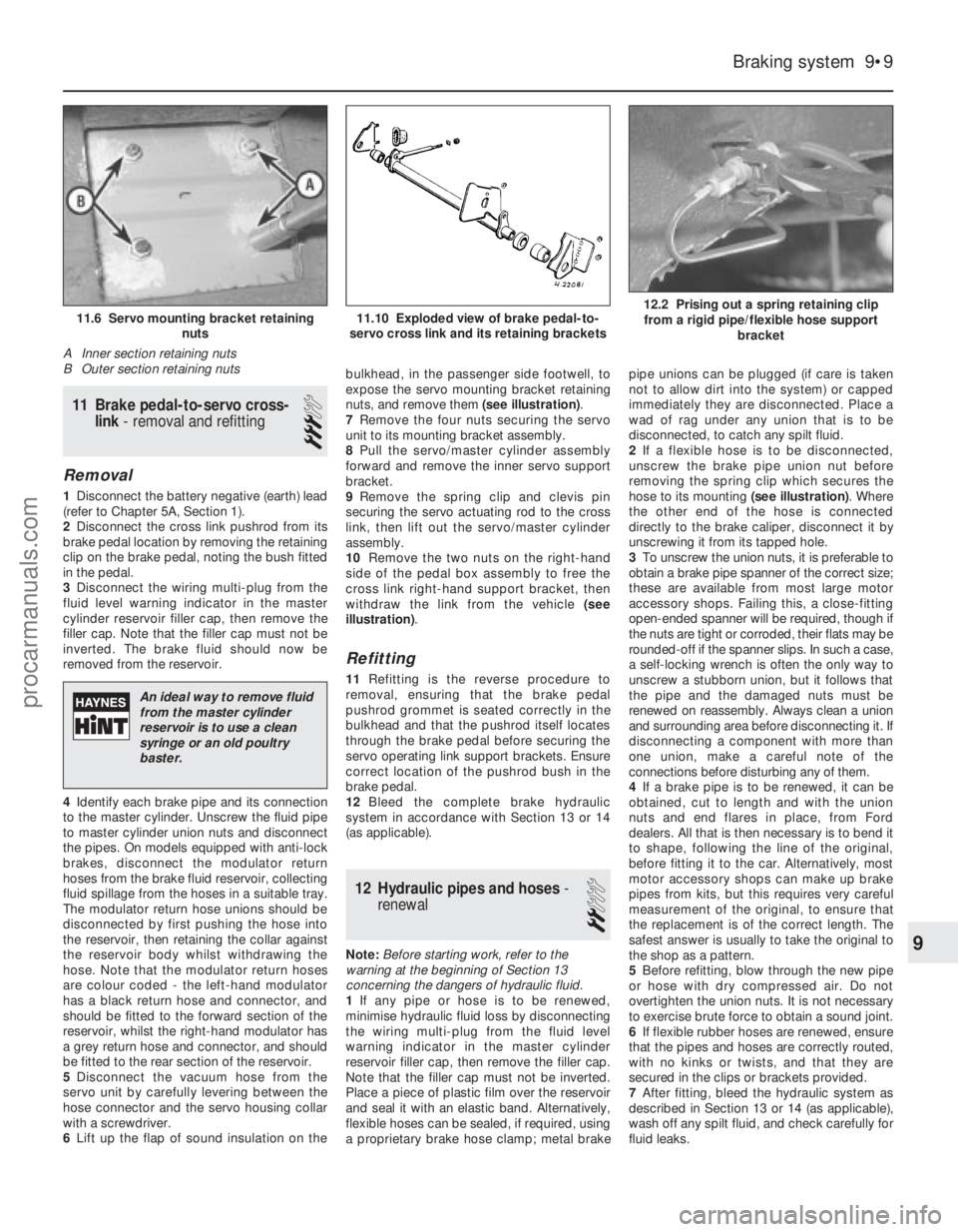
11 Brake pedal-to-servo cross-link - removal and refitting
3
Removal
1Disconnect the battery negative (earth) lead
(refer to Chapter 5A, Section 1).
2 Disconnect the cross link pushrod from its
brake pedal location by removing the retaining
clip on the brake pedal, noting the bush fitted
in the pedal.
3 Disconnect the wiring multi-plug from the
fluid level warning indicator in the master
cylinder reservoir filler cap, then remove the
filler cap. Note that the filler cap must not be
inverted. The brake fluid should now be
removed from the reservoir.
4 Identify each brake pipe and its connection
to the master cylinder. Unscrew the fluid pipe
to master cylinder union nuts and disconnect
the pipes. On models equipped with anti-lock
brakes, disconnect the modulator return
hoses from the brake fluid reservoir, collecting
fluid spillage from the hoses in a suitable tray.
The modulator return hose unions should be
disconnected by first pushing the hose into
the reservoir, then retaining the collar against
the reservoir body whilst withdrawing the
hose. Note that the modulator return hoses
are colour coded - the left-hand modulator
has a black return hose and connector, and
should be fitted to the forward section of the
reservoir, whilst the right-hand modulator has
a grey return hose and connector, and should
be fitted to the rear section of the reservoir.
5 Disconnect the vacuum hose from the
servo unit by carefully levering between the
hose connector and the servo housing collar
with a screwdriver.
6 Lift up the flap of sound insulation on the bulkhead, in the passenger side footwell, to
expose the servo mounting bracket retaining
nuts, and remove them
(see illustration).
7 Remove the four nuts securing the servo
unit to its mounting bracket assembly.
8 Pull the servo/master cylinder assembly
forward and remove the inner servo support
bracket.
9 Remove the spring clip and clevis pin
securing the servo actuating rod to the cross
link, then lift out the servo/master cylinder
assembly.
10 Remove the two nuts on the right-hand
side of the pedal box assembly to free the
cross link right-hand support bracket, then
withdraw the link from the vehicle (see
illustration) .
Refitting
11Refitting is the reverse procedure to
removal, ensuring that the brake pedal
pushrod grommet is seated correctly in the
bulkhead and that the pushrod itself locates
through the brake pedal before securing the
servo operating link support brackets. Ensure
correct location of the pushrod bush in the
brake pedal.
12 Bleed the complete brake hydraulic
system in accordance with Section 13 or 14
(as applicable).
12 Hydraulic pipes and hoses -
renewal
2
Note: Before starting work, refer to the
warning at the beginning of Section 13
concerning the dangers of hydraulic fluid.
1 If any pipe or hose is to be renewed,
minimise hydraulic fluid loss by disconnecting
the wiring multi-plug from the fluid level
warning indicator in the master cylinder
reservoir filler cap, then remove the filler cap.
Note that the filler cap must not be inverted.
Place a piece of plastic film over the reservoir
and seal it with an elastic band. Alternatively,
flexible hoses can be sealed, if required, using
a proprietary brake hose clamp; metal brake pipe unions can be plugged (if care is taken
not to allow dirt into the system) or capped
immediately they are disconnected. Place a
wad of rag under any union that is to be
disconnected, to catch any spilt fluid.
2
If a flexible hose is to be disconnected,
unscrew the brake pipe union nut before
removing the spring clip which secures the
hose to its mounting (see illustration). Where
the other end of the hose is connected
directly to the brake caliper, disconnect it by
unscrewing it from its tapped hole.
3 To unscrew the union nuts, it is preferable to
obtain a brake pipe spanner of the correct size;
these are available from most large motor
accessory shops. Failing this, a close-fitting
open-ended spanner will be required, though if
the nuts are tight or corroded, their flats may be
rounded-off if the spanner slips. In such a case,
a self-locking wrench is often the only way to
unscrew a stubborn union, but it follows that
the pipe and the damaged nuts must be
renewed on reassembly. Always clean a union
and surrounding area before disconnecting it. If
disconnecting a component with more than
one union, make a careful note of the
connections before disturbing any of them.
4 If a brake pipe is to be renewed, it can be
obtained, cut to length and with the union
nuts and end flares in place, from Ford
dealers. All that is then necessary is to bend it
to shape, following the line of the original,
before fitting it to the car. Alternatively, most
motor accessory shops can make up brake
pipes from kits, but this requires very careful
measurement of the original, to ensure that
the replacement is of the correct length. The
safest answer is usually to take the original to
the shop as a pattern.
5 Before refitting, blow through the new pipe
or hose with dry compressed air. Do not
overtighten the union nuts. It is not necessary
to exercise brute force to obtain a sound joint.
6 If flexible rubber hoses are renewed, ensure
that the pipes and hoses are correctly routed,
with no kinks or twists, and that they are
secured in the clips or brackets provided.
7 After fitting, bleed the hydraulic system as
described in Section 13 or 14 (as applicable),
wash off any spilt fluid, and check carefully for
fluid leaks.
Braking system 9•9
12.2 Prising out a spring retaining clip from a rigid pipe/flexible hose support bracket11.10 Exploded view of brake pedal-to-
servo cross link and its retaining brackets11.6 Servo mounting bracket retaining nuts
A Inner section retaining nuts
B Outer section retaining nuts
9
1595Ford Fiesta Remake
An ideal way to remove fluid from the master cylinder
reservoir is to use a clean
syringe or an old poultry
baster.
procarmanuals.com
http://vnx.su
Page 185 of 296
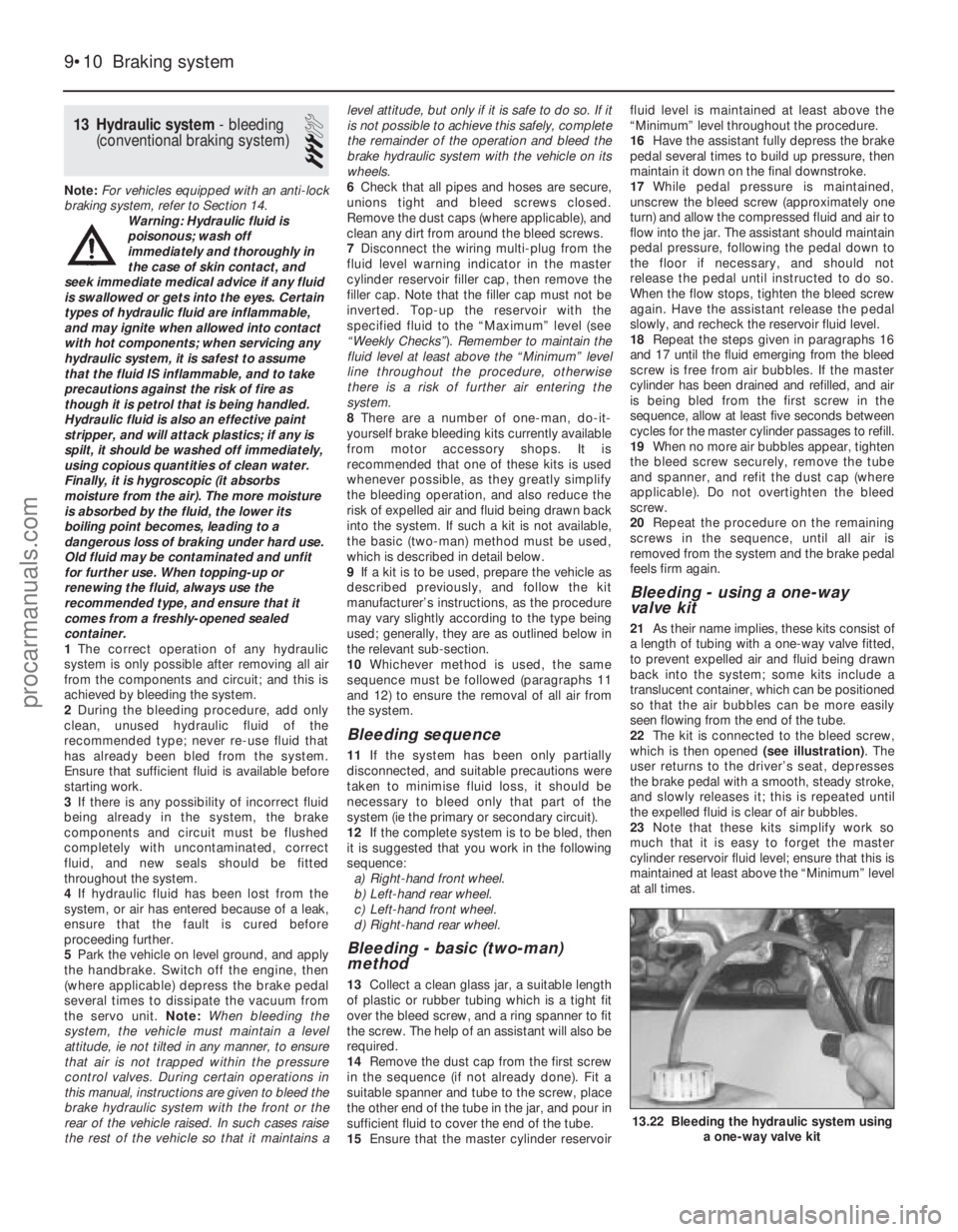
13 Hydraulic system- bleeding
(conventional braking system)
3
Note: For vehicles equipped with an anti-lock
braking system, refer to Section 14. Warning: Hydraulic fluid is
poisonous; wash off
immediately and thoroughly in
the case of skin contact, and
seek immediate medical advice if any fluid
is swallowed or gets into the eyes. Certain
types of hydraulic fluid are inflammable,
and may ignite when allowed into contact
with hot components; when servicing any
hydraulic system, it is safest to assume
that the fluid IS inflammable, and to take
precautions against the risk of fire as
though it is petrol that is being handled.
Hydraulic fluid is also an effective paint
stripper, and will attack plastics; if any is
spilt, it should be washed off immediately,
using copious quantities of clean water.
Finally, it is hygroscopic (it absorbs
moisture from the air). The more moisture
is absorbed by the fluid, the lower its
boiling point becomes, leading to a
dangerous loss of braking under hard use.
Old fluid may be contaminated and unfit
for further use. When topping-up or
renewing the fluid, always use the
recommended type, and ensure that it
comes from a freshly-opened sealed
container.
1 The correct operation of any hydraulic
system is only possible after removing all air
from the components and circuit; and this is
achieved by bleeding the system.
2 During the bleeding procedure, add only
clean, unused hydraulic fluid of the
recommended type; never re-use fluid that
has already been bled from the system.
Ensure that sufficient fluid is available before
starting work.
3 If there is any possibility of incorrect fluid
being already in the system, the brake
components and circuit must be flushed
completely with uncontaminated, correct
fluid, and new seals should be fitted
throughout the system.
4 If hydraulic fluid has been lost from the
system, or air has entered because of a leak,
ensure that the fault is cured before
proceeding further.
5 Park the vehicle on level ground, and apply
the handbrake. Switch off the engine, then
(where applicable) depress the brake pedal
several times to dissipate the vacuum from
the servo unit. Note:When bleeding the
system, the vehicle must maintain a level
attitude, ie not tilted in any manner, to ensure
that air is not trapped within the pressure
control valves. During certain operations in
this manual, instructions are given to bleed the
brake hydraulic system with the front or the
rear of the vehicle raised. In such cases raise
the rest of the vehicle so that it maintains a level attitude, but only if it is safe to do so. If it
is not possible to achieve this safely, complete
the remainder of the operation and bleed the
brake hydraulic system with the vehicle on its
wheels.
6
Check that all pipes and hoses are secure,
unions tight and bleed screws closed.
Remove the dust caps (where applicable), and
clean any dirt from around the bleed screws.
7 Disconnect the wiring multi-plug from the
fluid level warning indicator in the master
cylinder reservoir filler cap, then remove the
filler cap. Note that the filler cap must not be
inverted. Top-up the reservoir with the
specified fluid to the “Maximum” level (see
“Weekly Checks” ). Remember to maintain the
fluid level at least above the “Minimum” level
line throughout the procedure, otherwise
there is a risk of further air entering the
system.
8 There are a number of one-man, do-it-
yourself brake bleeding kits currently available
from motor accessory shops. It is
recommended that one of these kits is used
whenever possible, as they greatly simplify
the bleeding operation, and also reduce the
risk of expelled air and fluid being drawn back
into the system. If such a kit is not available,
the basic (two-man) method must be used,
which is described in detail below.
9 If a kit is to be used, prepare the vehicle as
described previously, and follow the kit
manufacturer’s instructions, as the procedure
may vary slightly according to the type being
used; generally, they are as outlined below in
the relevant sub-section.
10 Whichever method is used, the same
sequence must be followed (paragraphs 11
and 12) to ensure the removal of all air from
the system.
Bleeding sequence
11 If the system has been only partially
disconnected, and suitable precautions were
taken to minimise fluid loss, it should be
necessary to bleed only that part of the
system (ie the primary or secondary circuit).
12 If the complete system is to be bled, then
it is suggested that you work in the following
sequence: a) Right-hand front wheel.
b) Left-hand rear wheel.
c) Left-hand front wheel.
d) Right-hand rear wheel.
Bleeding - basic (two-man)
method
13 Collect a clean glass jar, a suitable length
of plastic or rubber tubing which is a tight fit
over the bleed screw, and a ring spanner to fit
the screw. The help of an assistant will also be
required.
14 Remove the dust cap from the first screw
in the sequence (if not already done). Fit a
suitable spanner and tube to the screw, place
the other end of the tube in the jar, and pour in
sufficient fluid to cover the end of the tube.
15 Ensure that the master cylinder reservoir fluid level is maintained at least above the
“Minimum” level throughout the procedure.
16
Have the assistant fully depress the brake
pedal several times to build up pressure, then
maintain it down on the final downstroke.
17 While pedal pressure is maintained,
unscrew the bleed screw (approximately one
turn) and allow the compressed fluid and air to
flow into the jar. The assistant should maintain
pedal pressure, following the pedal down to
the floor if necessary, and should not
release the pedal until instructed to do so.
When the flow stops, tighten the bleed screw
again. Have the assistant release the pedal
slowly, and recheck the reservoir fluid level.
18 Repeat the steps given in paragraphs 16
and 17 until the fluid emerging from the bleed
screw is free from air bubbles. If the master
cylinder has been drained and refilled, and air
is being bled from the first screw in the
sequence, allow at least five seconds between
cycles for the master cylinder passages to refill.
19 When no more air bubbles appear, tighten
the bleed screw securely, remove the tube
and spanner, and refit the dust cap (where
applicable). Do not overtighten the bleed
screw.
20 Repeat the procedure on the remaining
screws in the sequence, until all air is
removed from the system and the brake pedal
feels firm again.
Bleeding - using a one-way
valve kit
21 As their name implies, these kits consist of
a length of tubing with a one-way valve fitted,
to prevent expelled air and fluid being drawn
back into the system; some kits include a
translucent container, which can be positioned
so that the air bubbles can be more easily
seen flowing from the end of the tube.
22 The kit is connected to the bleed screw,
which is then opened (see illustration). The
user returns to the driver’s seat, depresses
the brake pedal with a smooth, steady stroke,
and slowly releases it; this is repeated until
the expelled fluid is clear of air bubbles.
23 Note that these kits simplify work so
much that it is easy to forget the master
cylinder reservoir fluid level; ensure that this is
maintained at least above the “Minimum” level
at all times.
9•10 Braking system
13.22 Bleeding the hydraulic system using a one-way valve kit
1595Ford Fiesta Remakeprocarmanuals.com
http://vnx.su
Page 186 of 296
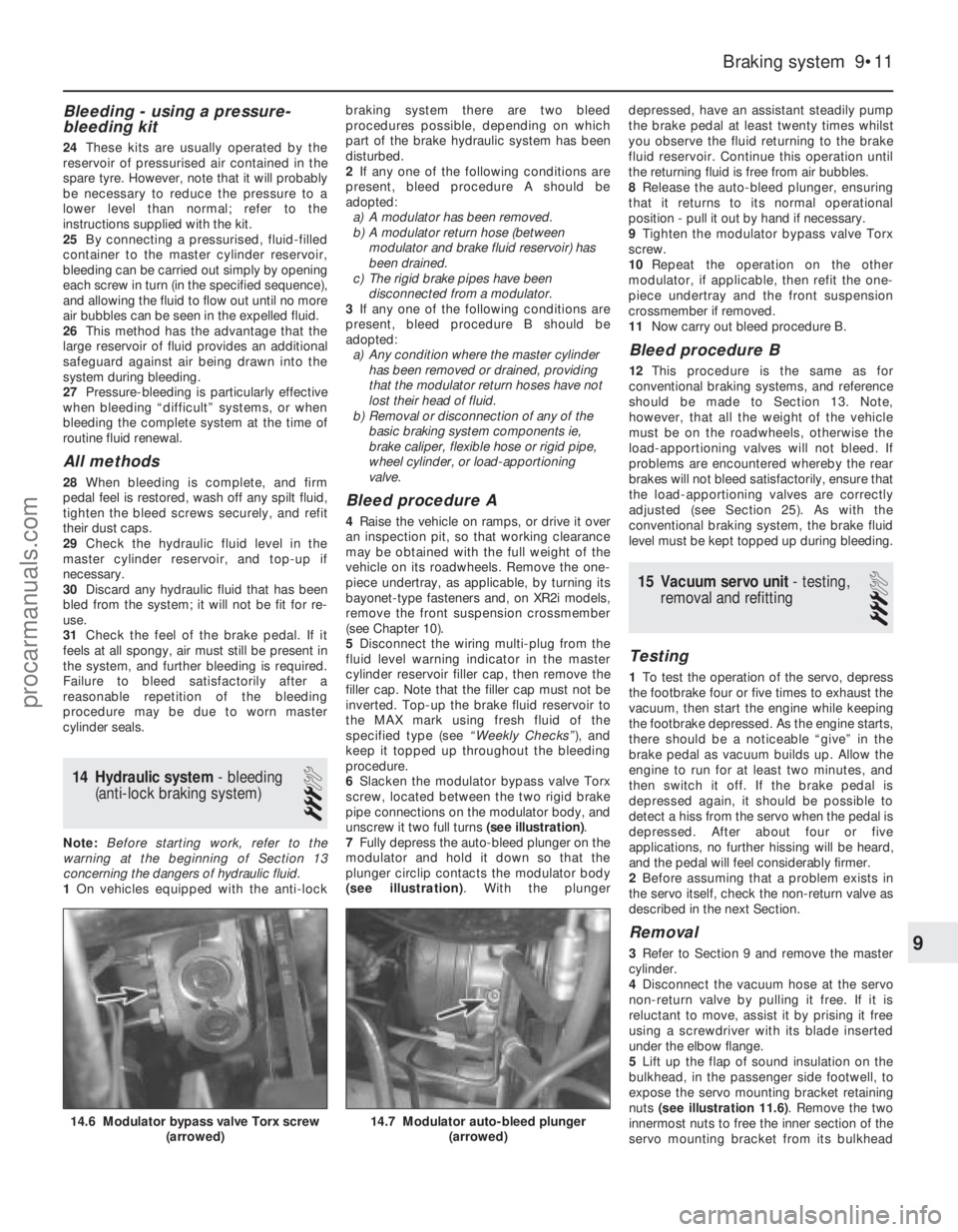
Bleeding - using a pressure-
bleeding kit
24These kits are usually operated by the
reservoir of pressurised air contained in the
spare tyre. However, note that it will probably
be necessary to reduce the pressure to a
lower level than normal; refer to the
instructions supplied with the kit.
25 By connecting a pressurised, fluid-filled
container to the master cylinder reservoir,
bleeding can be carried out simply by opening
each screw in turn (in the specified sequence),
and allowing the fluid to flow out until no more
air bubbles can be seen in the expelled fluid.
26 This method has the advantage that the
large reservoir of fluid provides an additional
safeguard against air being drawn into the
system during bleeding.
27 Pressure-bleeding is particularly effective
when bleeding “difficult” systems, or when
bleeding the complete system at the time of
routine fluid renewal.
All methods
28 When bleeding is complete, and firm
pedal feel is restored, wash off any spilt fluid,
tighten the bleed screws securely, and refit
their dust caps.
29 Check the hydraulic fluid level in the
master cylinder reservoir, and top-up if
necessary.
30 Discard any hydraulic fluid that has been
bled from the system; it will not be fit for re-
use.
31 Check the feel of the brake pedal. If it
feels at all spongy, air must still be present in
the system, and further bleeding is required.
Failure to bleed satisfactorily after a
reasonable repetition of the bleeding
procedure may be due to worn master
cylinder seals.
14 Hydraulic system - bleeding
(anti-lock braking system)
3
Note: Before starting work, refer to the
warning at the beginning of Section 13
concerning the dangers of hydraulic fluid.
1 On vehicles equipped with the anti-lock braking system there are two bleed
procedures possible, depending on which
part of the brake hydraulic system has been
disturbed.
2
If any one of the following conditions are
present, bleed procedure A should be
adopted: a) A modulator has been removed.
b) A modulator return hose (between
modulator and brake fluid reservoir) has
been drained.
c) The rigid brake pipes have been disconnected from a modulator.
3 If any one of the following conditions are
present, bleed procedure B should be
adopted: a) Any condition where the master cylinder
has been removed or drained, providing
that the modulator return hoses have not
lost their head of fluid.
b) Removal or disconnection of any of the
basic braking system components ie,
brake caliper, flexible hose or rigid pipe,
wheel cylinder, or load-apportioning
valve.
Bleed procedure A
4Raise the vehicle on ramps, or drive it over
an inspection pit, so that working clearance
may be obtained with the full weight of the
vehicle on its roadwheels. Remove the one-
piece undertray, as applicable, by turning its
bayonet-type fasteners and, on XR2i models,
remove the front suspension crossmember
(see Chapter 10).
5 Disconnect the wiring multi-plug from the
fluid level warning indicator in the master
cylinder reservoir filler cap, then remove the
filler cap. Note that the filler cap must not be
inverted. Top-up the brake fluid reservoir to
the MAX mark using fresh fluid of the
specified type (see “Weekly Checks”), and
keep it topped up throughout the bleeding
procedure.
6 Slacken the modulator bypass valve Torx
screw, located between the two rigid brake
pipe connections on the modulator body, and
unscrew it two full turns (see illustration).
7 Fully depress the auto-bleed plunger on the
modulator and hold it down so that the
plunger circlip contacts the modulator body
(see illustration) . With the plunger depressed, have an assistant steadily pump
the brake pedal at least twenty times whilst
you observe the fluid returning to the brake
fluid reservoir. Continue this operation until
the returning fluid is free from air bubbles.
8
Release the auto-bleed plunger, ensuring
that it returns to its normal operational
position - pull it out by hand if necessary.
9 Tighten the modulator bypass valve Torx
screw.
10 Repeat the operation on the other
modulator, if applicable, then refit the one-
piece undertray and the front suspension
crossmember if removed.
11 Now carry out bleed procedure B.
Bleed procedure B
12This procedure is the same as for
conventional braking systems, and reference
should be made to Section 13. Note,
however, that all the weight of the vehicle
must be on the roadwheels, otherwise the
load-apportioning valves will not bleed. If
problems are encountered whereby the rear
brakes will not bleed satisfactorily, ensure that
the load-apportioning valves are correctly
adjusted (see Section 25). As with the
conventional braking system, the brake fluid
level must be kept topped up during bleeding.
15 Vacuum servo unit - testing,
removal and refitting
3
Testing
1 To test the operation of the servo, depress
the footbrake four or five times to exhaust the
vacuum, then start the engine while keeping
the footbrake depressed. As the engine starts,
there should be a noticeable “give” in the
brake pedal as vacuum builds up. Allow the
engine to run for at least two minutes, and
then switch it off. If the brake pedal is
depressed again, it should be possible to
detect a hiss from the servo when the pedal is
depressed. After about four or five
applications, no further hissing will be heard,
and the pedal will feel considerably firmer.
2 Before assuming that a problem exists in
the servo itself, check the non-return valve as
described in the next Section.
Removal
3 Refer to Section 9 and remove the master
cylinder.
4 Disconnect the vacuum hose at the servo
non-return valve by pulling it free. If it is
reluctant to move, assist it by prising it free
using a screwdriver with its blade inserted
under the elbow flange.
5 Lift up the flap of sound insulation on the
bulkhead, in the passenger side footwell, to
expose the servo mounting bracket retaining
nuts (see illustration 11.6) . Remove the two
innermost nuts to free the inner section of the
servo mounting bracket from its bulkhead
Braking system 9•11
14.7 Modulator auto-bleed plunger (arrowed)14.6 Modulator bypass valve Torx screw (arrowed)
9
1595Ford Fiesta Remakeprocarmanuals.com
http://vnx.su
Page 187 of 296
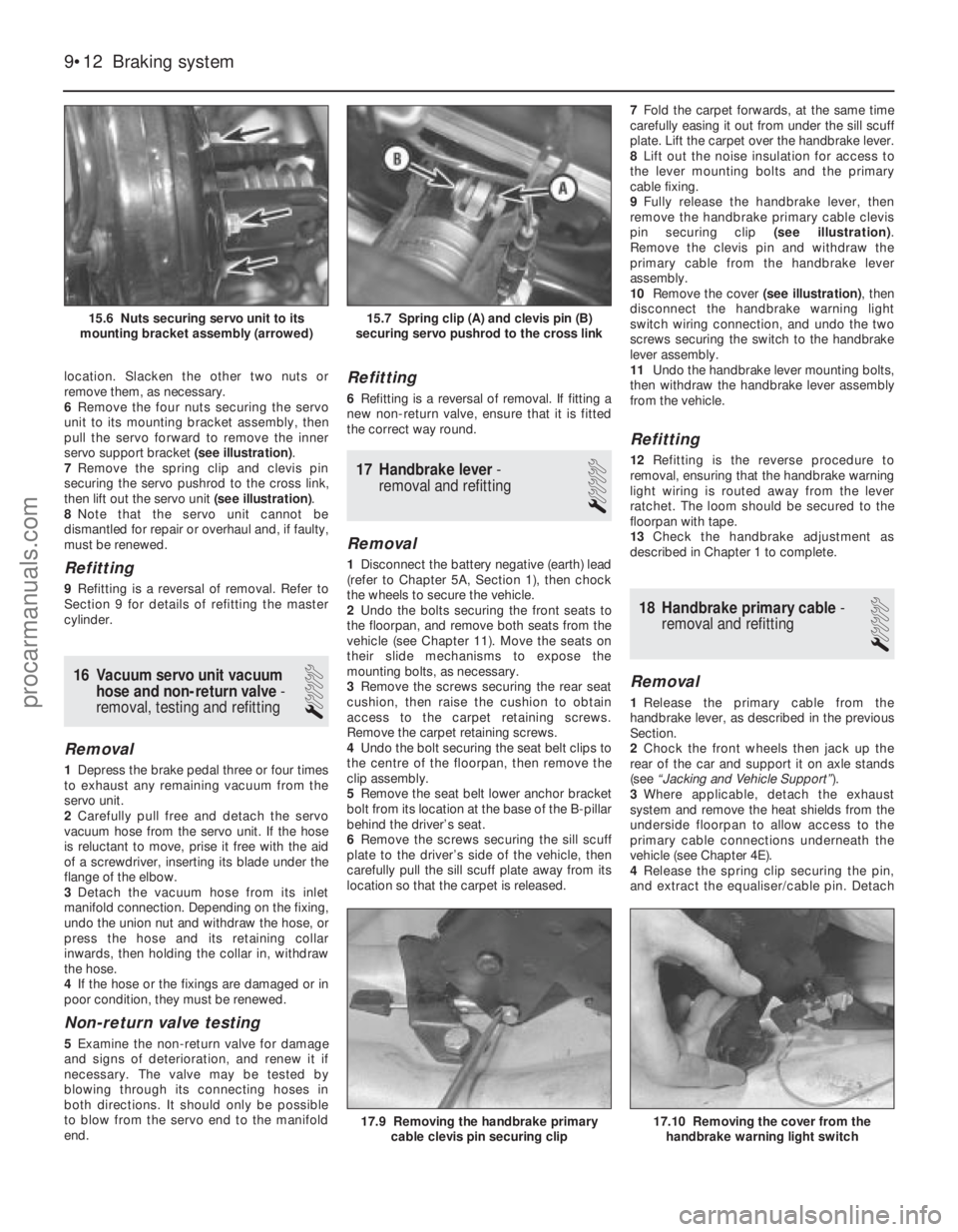
location. Slacken the other two nuts or
remove them, as necessary.
6Remove the four nuts securing the servo
unit to its mounting bracket assembly, then
pull the servo forward to remove the inner
servo support bracket (see illustration).
7 Remove the spring clip and clevis pin
securing the servo pushrod to the cross link,
then lift out the servo unit (see illustration).
8 Note that the servo unit cannot be
dismantled for repair or overhaul and, if faulty,
must be renewed.
Refitting
9 Refitting is a reversal of removal. Refer to
Section 9 for details of refitting the master
cylinder.
16 Vacuum servo unit vacuum
hose and non-return valve -
removal, testing and refitting
1
Removal
1 Depress the brake pedal three or four times
to exhaust any remaining vacuum from the
servo unit.
2 Carefully pull free and detach the servo
vacuum hose from the servo unit. If the hose
is reluctant to move, prise it free with the aid
of a screwdriver, inserting its blade under the
flange of the elbow.
3 Detach the vacuum hose from its inlet
manifold connection. Depending on the fixing,
undo the union nut and withdraw the hose, or
press the hose and its retaining collar
inwards, then holding the collar in, withdraw
the hose.
4 If the hose or the fixings are damaged or in
poor condition, they must be renewed.
Non-return valve testing
5 Examine the non-return valve for damage
and signs of deterioration, and renew it if
necessary. The valve may be tested by
blowing through its connecting hoses in
both directions. It should only be possible
to blow from the servo end to the manifold
end.
Refitting
6 Refitting is a reversal of removal. If fitting a
new non-return valve, ensure that it is fitted
the correct way round.
17 Handbrake lever -
removal and refitting
1
Removal
1 Disconnect the battery negative (earth) lead
(refer to Chapter 5A, Section 1), then chock
the wheels to secure the vehicle.
2 Undo the bolts securing the front seats to
the floorpan, and remove both seats from the
vehicle (see Chapter 11). Move the seats on
their slide mechanisms to expose the
mounting bolts, as necessary.
3 Remove the screws securing the rear seat
cushion, then raise the cushion to obtain
access to the carpet retaining screws.
Remove the carpet retaining screws.
4 Undo the bolt securing the seat belt clips to
the centre of the floorpan, then remove the
clip assembly.
5 Remove the seat belt lower anchor bracket
bolt from its location at the base of the B-pillar
behind the driver’s seat.
6 Remove the screws securing the sill scuff
plate to the driver’s side of the vehicle, then
carefully pull the sill scuff plate away from its
location so that the carpet is released. 7
Fold the carpet forwards, at the same time
carefully easing it out from under the sill scuff
plate. Lift the carpet over the handbrake lever.
8 Lift out the noise insulation for access to
the lever mounting bolts and the primary
cable fixing.
9 Fully release the handbrake lever, then
remove the handbrake primary cable clevis
pin securing clip (see illustration).
Remove the clevis pin and withdraw the
primary cable from the handbrake lever
assembly.
10 Remove the cover (see illustration), then
disconnect the handbrake warning light
switch wiring connection, and undo the two
screws securing the switch to the handbrake
lever assembly.
11 Undo the handbrake lever mounting bolts,
then withdraw the handbrake lever assembly
from the vehicle.
Refitting
12 Refitting is the reverse procedure to
removal, ensuring that the handbrake warning
light wiring is routed away from the lever
ratchet. The loom should be secured to the
floorpan with tape.
13 Check the handbrake adjustment as
described in Chapter 1 to complete.
18 Handbrake primary cable -
removal and refitting
1
Removal
1 Release the primary cable from the
handbrake lever, as described in the previous
Section.
2 Chock the front wheels then jack up the
rear of the car and support it on axle stands
(see “Jacking and Vehicle Support” ).
3 Where applicable, detach the exhaust
system and remove the heat shields from the
underside floorpan to allow access to the
primary cable connections underneath the
vehicle (see Chapter 4E).
4 Release the spring clip securing the pin,
and extract the equaliser/cable pin. Detach
9•12 Braking system
17.10 Removing the cover from the
handbrake warning light switch17.9 Removing the handbrake primary cable clevis pin securing clip
15.7 Spring clip (A) and clevis pin (B)
securing servo pushrod to the cross link15.6 Nuts securing servo unit to its
mounting bracket assembly (arrowed)
1595Ford Fiesta Remakeprocarmanuals.com
http://vnx.su
Page 188 of 296
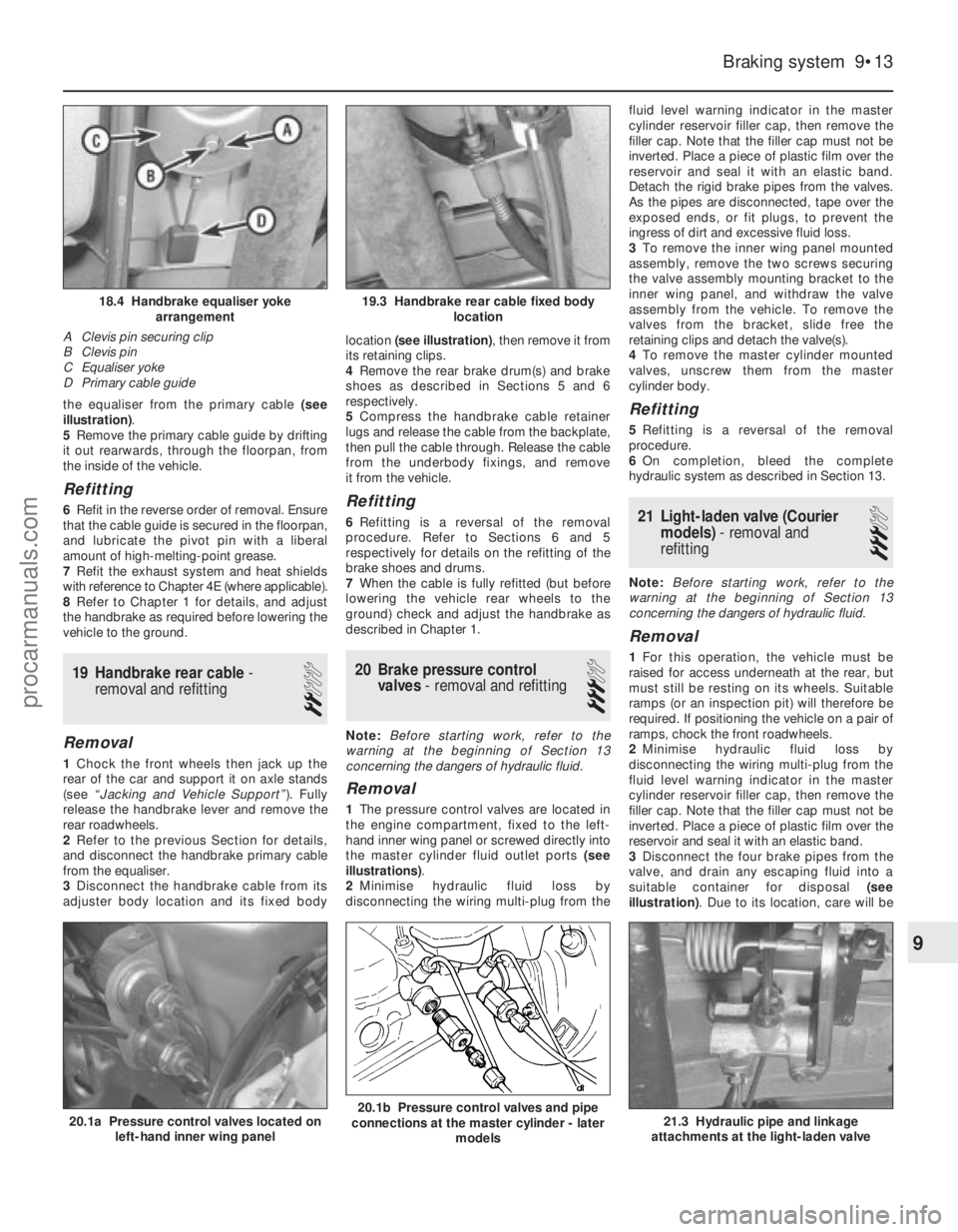
the equaliser from the primary cable (see
illustration) .
5 Remove the primary cable guide by drifting
it out rearwards, through the floorpan, from
the inside of the vehicle.
Refitting
6 Refit in the reverse order of removal. Ensure
that the cable guide is secured in the floorpan,
and lubricate the pivot pin with a liberal
amount of high-melting-point grease.
7 Refit the exhaust system and heat shields
with reference to Chapter 4E (where applicable).
8 Refer to Chapter 1 for details, and adjust
the handbrake as required before lowering the
vehicle to the ground.
19 Handbrake rear cable -
removal and refitting
2
Removal
1 Chock the front wheels then jack up the
rear of the car and support it on axle stands
(see “Jacking and Vehicle Support” ). Fully
release the handbrake lever and remove the
rear roadwheels.
2 Refer to the previous Section for details,
and disconnect the handbrake primary cable
from the equaliser.
3 Disconnect the handbrake cable from its
adjuster body location and its fixed body location
(see illustration) , then remove it from
its retaining clips.
4 Remove the rear brake drum(s) and brake
shoes as described in Sections 5 and 6
respectively.
5 Compress the handbrake cable retainer
lugs and release the cable from the backplate,
then pull the cable through. Release the cable
from the underbody fixings, and remove
it from the vehicle.
Refitting
6 Refitting is a reversal of the removal
procedure. Refer to Sections 6 and 5
respectively for details on the refitting of the
brake shoes and drums.
7 When the cable is fully refitted (but before
lowering the vehicle rear wheels to the
ground) check and adjust the handbrake as
described in Chapter 1.
20 Brake pressure control valves - removal and refitting
3
Note: Before starting work, refer to the
warning at the beginning of Section 13
concerning the dangers of hydraulic fluid.
Removal
1 The pressure control valves are located in
the engine compartment, fixed to the left-
hand inner wing panel or screwed directly into
the master cylinder fluid outlet ports (see
illustrations) .
2 Minimise hydraulic fluid loss by
disconnecting the wiring multi-plug from the fluid level warning indicator in the master
cylinder reservoir filler cap, then remove the
filler cap. Note that the filler cap must not be
inverted. Place a piece of plastic film over the
reservoir and seal it with an elastic band.
Detach the rigid brake pipes from the valves.
As the pipes are disconnected, tape over the
exposed ends, or fit plugs, to prevent the
ingress of dirt and excessive fluid loss.
3
To remove the inner wing panel mounted
assembly, remove the two screws securing
the valve assembly mounting bracket to the
inner wing panel, and withdraw the valve
assembly from the vehicle. To remove the
valves from the bracket, slide free the
retaining clips and detach the valve(s).
4 To remove the master cylinder mounted
valves, unscrew them from the master
cylinder body.
Refitting
5 Refitting is a reversal of the removal
procedure.
6 On completion, bleed the complete
hydraulic system as described in Section 13.
21 Light-laden valve (Courier models) - removal and
refitting
3
Note: Before starting work, refer to the
warning at the beginning of Section 13
concerning the dangers of hydraulic fluid.
Removal
1 For this operation, the vehicle must be
raised for access underneath at the rear, but
must still be resting on its wheels. Suitable
ramps (or an inspection pit) will therefore be
required. If positioning the vehicle on a pair of
ramps, chock the front roadwheels.
2 Minimise hydraulic fluid loss by
disconnecting the wiring multi-plug from the
fluid level warning indicator in the master
cylinder reservoir filler cap, then remove the
filler cap. Note that the filler cap must not be
inverted. Place a piece of plastic film over the
reservoir and seal it with an elastic band.
3 Disconnect the four brake pipes from the
valve, and drain any escaping fluid into a
suitable container for disposal (see
illustration) . Due to its location, care will be
Braking system 9•13
19.3 Handbrake rear cable fixed body
location18.4 Handbrake equaliser yokearrangement
A Clevis pin securing clip
B Clevis pin
C Equaliser yoke
D Primary cable guide
21.3 Hydraulic pipe and linkage
attachments at the light-laden valve20.1b Pressure control valves and pipe
connections at the master cylinder - later
models20.1a Pressure control valves located onleft-hand inner wing panel
9
1595Ford Fiesta Remakeprocarmanuals.com
http://vnx.su
Page 189 of 296
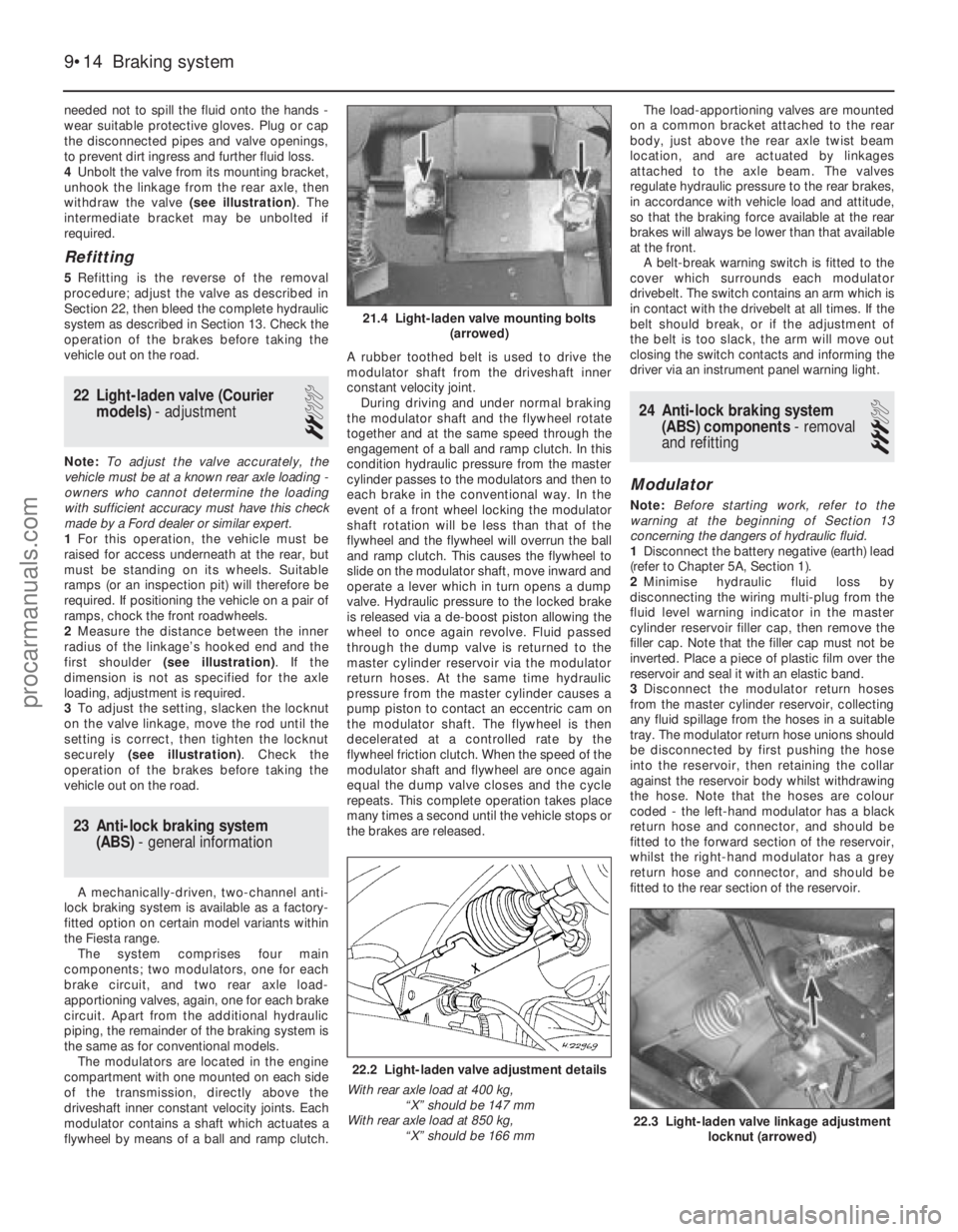
needed not to spill the fluid onto the hands -
wear suitable protective gloves. Plug or cap
the disconnected pipes and valve openings,
to prevent dirt ingress and further fluid loss.
4Unbolt the valve from its mounting bracket,
unhook the linkage from the rear axle, then
withdraw the valve (see illustration). The
intermediate bracket may be unbolted if
required.
Refitting
5 Refitting is the reverse of the removal
procedure; adjust the valve as described in
Section 22, then bleed the complete hydraulic
system as described in Section 13. Check the
operation of the brakes before taking the
vehicle out on the road.
22 Light-laden valve (Courier models) - adjustment
2
Note:To adjust the valve accurately, the
vehicle must be at a known rear axle loading -
owners who cannot determine the loading
with sufficient accuracy must have this check
made by a Ford dealer or similar expert.
1 For this operation, the vehicle must be
raised for access underneath at the rear, but
must be standing on its wheels. Suitable
ramps (or an inspection pit) will therefore be
required. If positioning the vehicle on a pair of
ramps, chock the front roadwheels.
2 Measure the distance between the inner
radius of the linkage’s hooked end and the
first shoulder (see illustration) . If the
dimension is not as specified for the axle
loading, adjustment is required.
3 To adjust the setting, slacken the locknut
on the valve linkage, move the rod until the
setting is correct, then tighten the locknut
securely (see illustration) . Check the
operation of the brakes before taking the
vehicle out on the road.
23 Anti-lock braking system (ABS) - general information
A mechanically-driven, two-channel anti-
lock braking system is available as a factory-
fitted option on certain model variants within
the Fiesta range.
The system comprises four main
components; two modulators, one for each
brake circuit, and two rear axle load-
apportioning valves, again, one for each brake
circuit. Apart from the additional hydraulic
piping, the remainder of the braking system is
the same as for conventional models. The modulators are located in the engine
compartment with one mounted on each side
of the transmission, directly above the
driveshaft inner constant velocity joints. Each
modulator contains a shaft which actuates a
flywheel by means of a ball and ramp clutch. A rubber toothed belt is used to drive the
modulator shaft from the driveshaft inner
constant velocity joint.
During driving and under normal braking
the modulator shaft and the flywheel rotate
together and at the same speed through the
engagement of a ball and ramp clutch. In this
condition hydraulic pressure from the master
cylinder passes to the modulators and then to
each brake in the conventional way. In the
event of a front wheel locking the modulator
shaft rotation will be less than that of the
flywheel and the flywheel will overrun the ball
and ramp clutch. This causes the flywheel to
slide on the modulator shaft, move inward and
operate a lever which in turn opens a dump
valve. Hydraulic pressure to the locked brake
is released via a de-boost piston allowing the
wheel to once again revolve. Fluid passed
through the dump valve is returned to the
master cylinder reservoir via the modulator
return hoses. At the same time hydraulic
pressure from the master cylinder causes a
pump piston to contact an eccentric cam on
the modulator shaft. The flywheel is then
decelerated at a controlled rate by the
flywheel friction clutch. When the speed of the
modulator shaft and flywheel are once again
equal the dump valve closes and the cycle
repeats. This complete operation takes place
many times a second until the vehicle stops or
the brakes are released. The load-apportioning valves are mounted
on a common bracket attached to the rear
body, just above the rear axle twist beam
location, and are actuated by linkages
attached to the axle beam. The valves
regulate hydraulic pressure to the rear brakes,
in accordance with vehicle load and attitude,
so that the braking force available at the rear
brakes will always be lower than that available
at the front. A belt-break warning switch is fitted to the
cover which surrounds each modulator
drivebelt. The switch contains an arm which is
in contact with the drivebelt at all times. If the
belt should break, or if the adjustment of
the belt is too slack, the arm will move out
closing the switch contacts and informing the
driver via an instrument panel warning light.
24 Anti-lock braking system (ABS) components - removal
and refitting
3
Modulator
Note: Before starting work, refer to the
warning at the beginning of Section 13
concerning the dangers of hydraulic fluid.
1 Disconnect the battery negative (earth) lead
(refer to Chapter 5A, Section 1).
2 Minimise hydraulic fluid loss by
disconnecting the wiring multi-plug from the
fluid level warning indicator in the master
cylinder reservoir filler cap, then remove the
filler cap. Note that the filler cap must not be
inverted. Place a piece of plastic film over the
reservoir and seal it with an elastic band.
3 Disconnect the modulator return hoses
from the master cylinder reservoir, collecting
any fluid spillage from the hoses in a suitable
tray. The modulator return hose unions should
be disconnected by first pushing the hose
into the reservoir, then retaining the collar
against the reservoir body whilst withdrawing
the hose. Note that the hoses are colour
coded - the left-hand modulator has a black
return hose and connector, and should be
fitted to the forward section of the reservoir,
whilst the right-hand modulator has a grey
return hose and connector, and should be
fitted to the rear section of the reservoir.
9•14 Braking system
22.3 Light-laden valve linkage adjustment locknut (arrowed)
22.2 Light-laden valve adjustment details
With rear axle load at 400 kg, “X” should be 147 mm
With rear axle load at 850 kg,
“X” should be 166 mm
21.4 Light-laden valve mounting bolts (arrowed)
1595Ford Fiesta Remakeprocarmanuals.com
http://vnx.su
Page 190 of 296
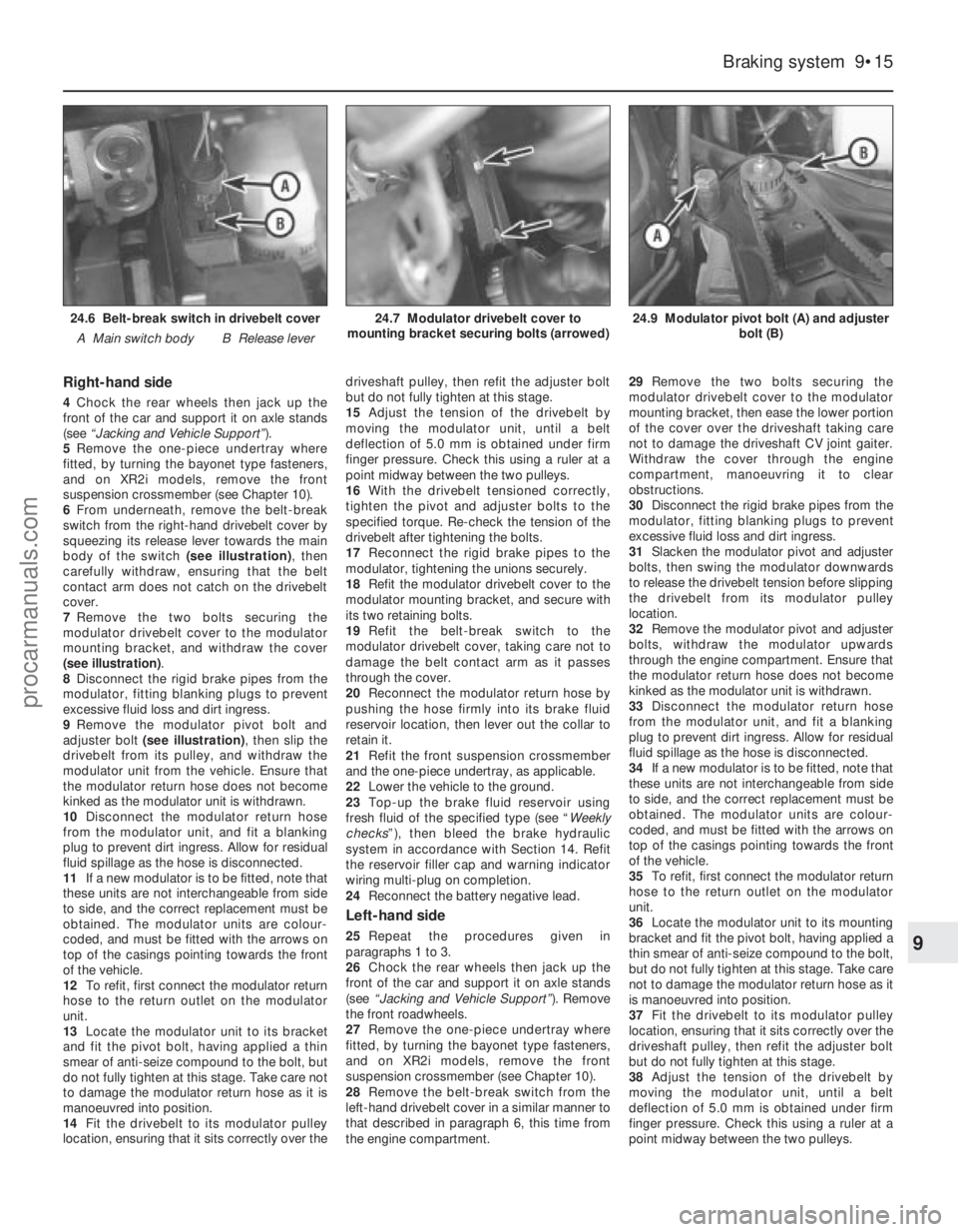
Right-hand side
4Chock the rear wheels then jack up the
front of the car and support it on axle stands
(see “Jacking and Vehicle Support” ).
5 Remove the one-piece undertray where
fitted, by turning the bayonet type fasteners,
and on XR2i models, remove the front
suspension crossmember (see Chapter 10).
6 From underneath, remove the belt-break
switch from the right-hand drivebelt cover by
squeezing its release lever towards the main
body of the switch (see illustration), then
carefully withdraw, ensuring that the belt
contact arm does not catch on the drivebelt
cover.
7 Remove the two bolts securing the
modulator drivebelt cover to the modulator
mounting bracket, and withdraw the cover
(see illustration) .
8 Disconnect the rigid brake pipes from the
modulator, fitting blanking plugs to prevent
excessive fluid loss and dirt ingress.
9 Remove the modulator pivot bolt and
adjuster bolt (see illustration) , then slip the
drivebelt from its pulley, and withdraw the
modulator unit from the vehicle. Ensure that
the modulator return hose does not become
kinked as the modulator unit is withdrawn.
10 Disconnect the modulator return hose
from the modulator unit, and fit a blanking
plug to prevent dirt ingress. Allow for residual
fluid spillage as the hose is disconnected.
11 If a new modulator is to be fitted, note that
these units are not interchangeable from side
to side, and the correct replacement must be
obtained. The modulator units are colour-
coded, and must be fitted with the arrows on
top of the casings pointing towards the front
of the vehicle.
12 To refit, first connect the modulator return
hose to the return outlet on the modulator
unit.
13 Locate the modulator unit to its bracket
and fit the pivot bolt, having applied a thin
smear of anti-seize compound to the bolt, but
do not fully tighten at this stage. Take care not
to damage the modulator return hose as it is
manoeuvred into position.
14 Fit the drivebelt to its modulator pulley
location, ensuring that it sits correctly over the driveshaft pulley, then refit the adjuster bolt
but do not fully tighten at this stage.
15
Adjust the tension of the drivebelt by
moving the modulator unit, until a belt
deflection of 5.0 mm is obtained under firm
finger pressure. Check this using a ruler at a
point midway between the two pulleys.
16 With the drivebelt tensioned correctly,
tighten the pivot and adjuster bolts to the
specified torque. Re-check the tension of the
drivebelt after tightening the bolts.
17 Reconnect the rigid brake pipes to the
modulator, tightening the unions securely.
18 Refit the modulator drivebelt cover to the
modulator mounting bracket, and secure with
its two retaining bolts.
19 Refit the belt-break switch to the
modulator drivebelt cover, taking care not to
damage the belt contact arm as it passes
through the cover.
20 Reconnect the modulator return hose by
pushing the hose firmly into its brake fluid
reservoir location, then lever out the collar to
retain it.
21 Refit the front suspension crossmember
and the one-piece undertray, as applicable.
22 Lower the vehicle to the ground.
23 Top-up the brake fluid reservoir using
fresh fluid of the specified type (see “ Weekly
checks ”), then bleed the brake hydraulic
system in accordance with Section 14. Refit
the reservoir filler cap and warning indicator
wiring multi-plug on completion.
24 Reconnect the battery negative lead.
Left-hand side
25Repeat the procedures given in
paragraphs 1 to 3.
26 Chock the rear wheels then jack up the
front of the car and support it on axle stands
(see “Jacking and Vehicle Support” ). Remove
the front roadwheels.
27 Remove the one-piece undertray where
fitted, by turning the bayonet type fasteners,
and on XR2i models, remove the front
suspension crossmember (see Chapter 10).
28 Remove the belt-break switch from the
left-hand drivebelt cover in a similar manner to
that described in paragraph 6, this time from
the engine compartment. 29
Remove the two bolts securing the
modulator drivebelt cover to the modulator
mounting bracket, then ease the lower portion
of the cover over the driveshaft taking care
not to damage the driveshaft CV joint gaiter.
Withdraw the cover through the engine
compartment, manoeuvring it to clear
obstructions.
30 Disconnect the rigid brake pipes from the
modulator, fitting blanking plugs to prevent
excessive fluid loss and dirt ingress.
31 Slacken the modulator pivot and adjuster
bolts, then swing the modulator downwards
to release the drivebelt tension before slipping
the drivebelt from its modulator pulley
location.
32 Remove the modulator pivot and adjuster
bolts, withdraw the modulator upwards
through the engine compartment. Ensure that
the modulator return hose does not become
kinked as the modulator unit is withdrawn.
33 Disconnect the modulator return hose
from the modulator unit, and fit a blanking
plug to prevent dirt ingress. Allow for residual
fluid spillage as the hose is disconnected.
34 If a new modulator is to be fitted, note that
these units are not interchangeable from side
to side, and the correct replacement must be
obtained. The modulator units are colour-
coded, and must be fitted with the arrows on
top of the casings pointing towards the front
of the vehicle.
35 To refit, first connect the modulator return
hose to the return outlet on the modulator
unit.
36 Locate the modulator unit to its mounting
bracket and fit the pivot bolt, having applied a
thin smear of anti-seize compound to the bolt,
but do not fully tighten at this stage. Take care
not to damage the modulator return hose as it
is manoeuvred into position.
37 Fit the drivebelt to its modulator pulley
location, ensuring that it sits correctly over the
driveshaft pulley, then refit the adjuster bolt
but do not fully tighten at this stage.
38 Adjust the tension of the drivebelt by
moving the modulator unit, until a belt
deflection of 5.0 mm is obtained under firm
finger pressure. Check this using a ruler at a
point midway between the two pulleys.
Braking system 9•15
24.9 Modulator pivot bolt (A) and adjuster bolt (B)24.7 Modulator drivebelt cover to
mounting bracket securing bolts (arrowed)24.6 Belt-break switch in drivebelt cover
A Main switch body B Release lever
9
1595Ford Fiesta Remakeprocarmanuals.com
http://vnx.su